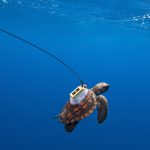Coral scientists at NOAA’s Atlantic Oceanic and Meteorological Laboratory (AOML) are in the process of analyzing data that may shed light on the sub-lethal effects of sedimentation stress in coral larvae. Scientists recently conducted a series of lab experiments aimed at assessing the effects of Port of Miami dredge sediments on the larval performance of the Caribbean threatened coral Orbicella faveolata (also known as the mountainous star coral). Preliminary analysis suggests significant effects of sedimentation on both the survival and settlement of coral larvae.
Recent dredging operations to expand the Port of Miami have led to increased sedimentation and turbidity at the reef sites surrounding the port, likely to have direct and indirect negative effects on coral survival, metabolism, growth, and reproduction. Sedimentation can directly smother a reef, or increase turbidity in coastal waters, reducing the light available to corals needed to photosynthesize. To date, the sub-lethal effects of sedimentation stress are not well understood in early life stages of coral species, and this information is needed to help develop appropriate actions plans, especially for Endangered Species Act (ESA) listed species. O. faveolata is currently listed on the ESA as threatened, meaning the species is likely to become endangered within the foreseeable future.

An adult colony of Orbicella faveolata: an important reef-building species that forms large mountainous colonies, currently listed as threatened under the ESA. Image credit: NOAA
To carry out the lab experiments and determine the effect of dredged sediments, scientists collected sediments from both the Port of Miami dredge site and from a healthy reef. Scientists then exposed O. faveolata coral larvae to one of five different sediment treatments: a no sedimentation control, a low and high sedimentation dose from healthy reef sediments, and a low and high sedimentation dose from the “port” dredged sediment. A respirometer was used to measure the oxygen consumption of coral larvae, in addition to assessing the effects on coral settlement and mortality.

AOML Scientist Xaymara Serrano collects sediments from a site near the Port of Miami to use in laboratory experiments. Image credit: NOAA
Coral larvae undergo a pelagic phase during which they are free living in the water column, before permanently settling on the ocean floor. The findings of this study suggest that the success of early life stages of O. faveolata may be compromised by the presence of Port of Miami sediments during this pelagic phase. Preliminary analysis suggests significant effects of the “port” type of sediment in the survival of larvae after 24 hours of exposure, and on settlement after a 1-week recovery period, even at the low dose treatment. Respiration data are currently being analyzed.
Florida’s reefs are invaluable to the economy, ecology, and livelihood of south Florida. These findings help provide data to local environmental managers, which might support the implementation of environmental policies aimed at minimizing the impacts of coastal development and dredging operations, especially during periods of coral reproduction.
Originally Published October 2017 by Sierra Sarkis








